Search
« Previous |
41 - 50 of 64
|
Next »
Search Results
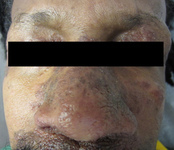
- Title:
- Sarcoidosis, Image 2
- Description:
- Sarcoidosis is a disease which can affect many organs within the body. It causes the development of granulomas. Granulomas are masses resembling little tumors. They are made up of clumps of cells from the immune system.
- Keyword:
- fibrosis, Granuloma
- Subject:
- Hemic and Lymphatic Diseases, Lymphoproliferative Disorders, Sarcoidosis, Lymphatic Diseases
- Creator:
- Metropolitan Hospital Center, Kathryn Russel, MD
- Publisher:
- Metropolitan Hospital Center
- Language:
- English
- Copyright Holder:
- Metropolitan Hospital Center
- Rights:
- http://www.i-human.com/service-agreement-print
- Resource Type:
- Photo

- Title:
- Squamous Cell Carcinoma, Image 1
- Description:
- A slow-growing malignant tumor of squamous epithelium, frequently found in the lungs and skin and occurring also in the anus, cervix, larynx, nose, and bladder. The neoplastic cells characteristically resemble prickle cells and form keratin pearls. Also called epidermoid carcinoma.
- Keyword:
- Carcinoma, Carcinoma, Squamous Cell, Cancer, tumor, Neoplasms
- Creator:
- Metropolitan Hospital Center, Kathryn Russel, MD
- Publisher:
- Metropolitan Hospital Center
- Language:
- English
- Copyright Holder:
- Metropolitan Hospital Center
- Rights:
- http://www.i-human.com/service-agreement-print
- Resource Type:
- Photo
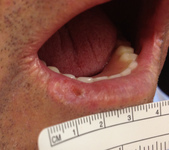
- Title:
- Squamous Cell Carcinoma, Image 2
- Description:
- A slow-growing malignant tumor of squamous epithelium, frequently found in the lungs and skin and occurring also in the anus, cervix, larynx, nose, and bladder. The neoplastic cells characteristically resemble prickle cells and form keratin pearls. Also called epidermoid carcinoma.
- Keyword:
- Neoplasms, tumor, Carcinoma, Squamous Cell, Carcinoma, Cancer
- Creator:
- Metropolitan Hospital Center, Kathryn Russel, MD
- Publisher:
- Metropolitan Hospital Center
- Language:
- English
- Copyright Holder:
- Metropolitan Hospital Center
- Rights:
- http://www.i-human.com/service-agreement-print
- Resource Type:
- Photo
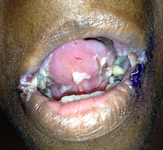
- Title:
- Pemphigus Vulgaris
- Description:
- Pemphigus is any of a group of diseases characterized by successive crops of large bullae (“water blisters”). Although rare, they are serious and require prompt treatment. The cause is unknown; they seem to occur only in adults and can occur in acute or chronic form. Pemphigus vulga´ris the most common and severe form of pemphigus, usually occurring between the ages of 40 and 60, characterized by the chronic development of flaccid, easily ruptured bullae upon apparently normal skin and mucous membranes, beginning focally but progressing to become generalized, leaving large, weeping, denuded surfaces that become partially crusted over with little or no tendency to heal and that enlarge by confluence. In untreated cases, sepsis, cachexia, and electrolyte imbalance may occur and lead to death.
- Keyword:
- Bullae, blisters, Pemphigus, Skin Diseases, Vesiculobullous
- Subject:
- Skin and Connective Tissue Diseases
- Creator:
- Metropolitan Hospital Center, Kathryn Russel, MD
- Publisher:
- Metropolitan Hospital Center
- Language:
- English
- Copyright Holder:
- Metropolitan Hospital Center
- Rights:
- http://www.i-human.com/service-agreement-print
- Resource Type:
- Photo
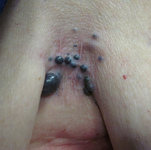
- Title:
- Metastatic Melanoma (Recurrent)
- Description:
- Melanoma
A malignant neoplasm derived from cells that are capable of forming melanin, which may occur in the skin of any part of the body, in the eye, or, rarely, in the mucous membranes of the genitalia, anus, oral cavity, or other sites. It occurs mostly in adults and may originate de novo or from a pigmented nevus or malignant lentigo. Melanomas frequently metastasize widely, and the regional lymph nodes, liver, lungs, and brain are likely to be involved. The incidence of malignant skin melanomas is rising rapidly in all parts of the world.
- Keyword:
- Skin, Melanoma, pigment, melanin, malignant, Neoplasms by Histologic Type, Neoplasms, Neoplasms, Germ Cell and Embryonal, cancer, Nevi and Melanomas
- Subject:
- Melanoma, Neuroectodermal Tumors, Neoplasms, Nerve Tissue
- Creator:
- Metropolitan Hospital Center, Kathryn Russel, MD
- Publisher:
- Metropolitan Hospital Center
- Language:
- English
- Copyright Holder:
- Metropolitan Hospital Center
- Rights:
- http://www.i-human.com/service-agreement-print
- Resource Type:
- Photo
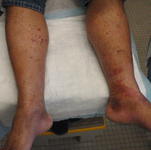
- Title:
- Leukocytoclastic Vasculitis, Palpable Purpura On Exam
- Description:
- Cutaneous acute vasculitis characterized clinically by palpable purpura, especially of the legs, and histologically by exudation of theneutrophils and sometimes fibrin around dermal venules, with nuclear dust and extravasation of red cells; may be limited to the skin orinvolve other tissues as in Henoch-Schönlein purpura.
- Keyword:
- Vasculitis, Leukocytoclastic, Cutaneous, Leukocytoclastic vasculitis, Vascular Diseases, Extracellular cholesterosis, Petechiae, skin
- Subject:
- Hypersensitivity, Immune Complex Diseases, Immune System Diseases, Cardiovascular Diseases, Vasculitis, Leukocytoclastic, Cutaneous
- Creator:
- Metropolitan Hospital Center, Kathryn Russel, MD
- Publisher:
- Metropolitan Hospital Center
- Language:
- English
- Copyright Holder:
- Metropolitan Hospital Center
- Rights:
- http://www.i-human.com/service-agreement-print
- Resource Type:
- Photo
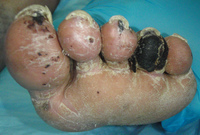
- Title:
- Cutaneous Vasculitis With Skin Necrosis, SLE Patient, Image 3
- Description:
- Vasculitis (plural: vasculitides) is a group of disorders that destroy blood vessels by inflammation. Both arteries and veins are affected. Lymphangitis is sometimes considered a type of vasculitis.[3] Vasculitis is primarily due to leukocyte migration and resultant damage.
- Keyword:
- blood vessels, Cell Physiological Processes, Vascular Diseases, Inflammation, Cell Physiological Phenomena
- Subject:
- Cell Death, Necrosis, Cardiovascular Diseases, Vasculitis, Pathological Conditions, Signs and Symptoms, Pathologic Processes
- Creator:
- Metropolitan Hospital Center, Kathryn Russel, MD
- Publisher:
- Metropolitan Hospital Center
- Language:
- English
- Copyright Holder:
- Metropolitan Hospital Center
- Rights:
- http://www.i-human.com/service-agreement-print
- Resource Type:
- Photo
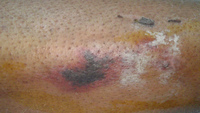
- Title:
- Cutaneous Vasculitis With Skin Necrosis, SLE Patient, Image 1
- Description:
- Vasculitis (plural: vasculitides) is a group of disorders that destroy blood vessels by inflammation. Both arteries and veins are affected. Lymphangitis is sometimes considered a type of vasculitis.[3] Vasculitis is primarily due to leukocyte migration and resultant damage.
- Keyword:
- blood vessels, Cell Physiological Processes, Cell Physiological Phenomena, Inflammation, Vascular Diseases
- Subject:
- Cell Death, Vasculitis, Pathological Conditions, Signs and Symptoms, Cardiovascular Diseases, Necrosis, Pathologic Processes
- Creator:
- Metropolitan Hospital Center, Kathryn Russel, MD
- Publisher:
- Metropolitan Hospital Center
- Language:
- English
- Copyright Holder:
- Metropolitan Hospital Center
- Rights:
- http://www.i-human.com/service-agreement-print
- Resource Type:
- Photo
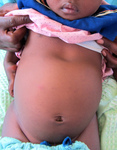
- Title:
- Kwashiorkor (Kenya)
- Description:
- A syndrome produced by severe protein deficiency, characterized by retarded growth, changes in skin and hair pigment, edema, and pathologic changes in the liver, including fatty infiltration, necrosis, and fibrosis. The word is a local name in Gold Coast, Africa, meaning "displaced child". Although first reported from Africa, kwashiorkor is now known throughout the world, but mainly in the tropics and subtropics. It is considered to be related to marasmus.
- Keyword:
- Nutritional deficiency, protein deficiency
- Subject:
- Nutritional and Metabolic Diseases, Kwashiorkor, Deficiency Diseases, Protein Deficiency, Malnutrition, Nutrition Disorders
- Creator:
- Metropolitan Hospital Center, Kathryn Russel, MD
- Publisher:
- Metropolitan Hospital Center
- Language:
- English
- Copyright Holder:
- Metropolitan Hospital Center
- Rights:
- http://www.i-human.com/service-agreement-print
- Resource Type:
- Photo

- Title:
- Cutaneous T-Cell Lymphoma, Mycoses Fungoides, Image 1
- Description:
- A group of heterogeneous lymphoid tumors representing malignant transformations of T-lymphocytes. Photo from clinic based in Kenya.
- Keyword:
- malignant, Neoplasms by Histologic Type, T-lymphocytes, Lymphoma, T-Cell, Neoplasms, Lymphoid tumor
- Subject:
- Hemic and Lymphatic Diseases, Lymphatic Diseases, Lymphoproliferative Disorders, Lymphoma, Lymphoma, T-Cell, Immune System Diseases, Immunoproliferative Disorders
- Creator:
- Metropolitan Hospital Center, Kathryn Russel, MD
- Publisher:
- Metropolitan Hospital Center
- Language:
- English
- Copyright Holder:
- Metropolitan Hospital Center
- Rights:
- http://www.i-human.com/service-agreement-print
- Resource Type:
- Photo